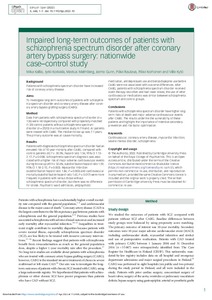Impaired long-term outcomes of patients with schizophrenia spectrum disorder after coronary artery bypass surgery: nationwide case-control study
Kallio Mika; Korkeila Jyrki; Malmberg Markus; Gunn Jarmo; Rautava Päivi; Korhonen Päivi; Kytö Ville
https://urn.fi/URN:NBN:fi-fe2022081154781
Tiivistelmä
Background: Patients with schizophrenia spectrum disorder have increased risk of coronary artery disease.
Aims: To investigate long-term outcomes of patients with schizophrenia spectrum disorder and coronary artery disease after coronary artery bypass grafting surgery (CABG).
Method: Data from patients with schizophrenia spectrum disorder (n = 126) were retrospectively compared with propensity-matched (1:20) control patients without schizophrenia spectrum disorder (n = 2520) in a multicentre study in Finland. All patients were treated with CABG. The median follow-up was 7.1 years. The primary outcome was all-cause mortality.
Results: Patients with diagnosed schizophrenia spectrum disorder had an elevated risk of 10-year mortality after CABG, compared with control patients (42.7 v. 30.3%; hazard ratio 1.56; 95% CI 1.13-2.17; P = 0.008). Schizophrenia spectrum diagnosis was associated with a higher risk of major adverse cardiovascular events during follow-up (49.9 v. 32.6%, subdistribution hazard ratio 1.59; 95% CI 1.18-2.15; P = 0.003). Myocardial infarction (subdistribution hazard ratio 1.86; P = 0.003) and cardiovascular mortality (subdistribution hazard ratio 1.65; P = 0.017) were more frequent in patients with versus those without schizophrenia spectrum disorder, but there was no difference for stroke. Psychiatric ward admission, antipsychotic medication, antidepressant use and benzodiazepine use before CABG were not associated with outcome differences. After CABG, patients with schizophrenia spectrum disorder received statin therapy less often and had lower doses; the use of other cardiovascular medications was similar between schizophrenia spectrum and control groups.
Conclusions: Patients with schizophrenia spectrum disorder have higher long-term risks of death and major adverse cardiovascular events after CABG. The results underline the vulnerability of these patients and highlight the importance of intensive secondary prevention and risk factor optimisation.
Kokoelmat
- Rinnakkaistallenteet [27094]
